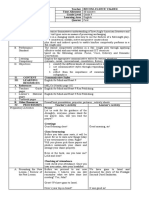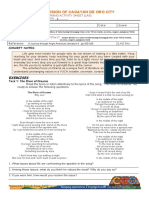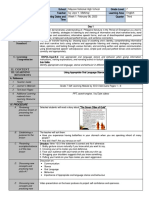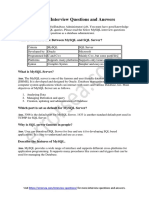Telephone Lesson Plan
Telephone Lesson Plan
Uploaded by
api-235994485Copyright:
Available Formats
Telephone Lesson Plan
Telephone Lesson Plan
Uploaded by
api-235994485Original Title
Copyright
Available Formats
Share this document
Did you find this document useful?
Is this content inappropriate?
Copyright:
Available Formats
Telephone Lesson Plan
Telephone Lesson Plan
Uploaded by
api-235994485Copyright:
Available Formats
History of the Telephone
3
rd
Grade: Social Studies
April 10, 2014
Brittney Guyer
I. Instructional Objectives:
Social Studies: After the lesson on the history of the telephone, the students will create a
visual timeline with 80% accuracy. (Standard SS.3.16)
Introduction
A. Label the Learning: Today boys and girls, we will learn about the history of the
telephone
B. Relate to Students Frame of Reference: Raise your hand if you currently have a cell
phone.
C. Relate to Prior and Future Learning: Yesterday, we learned about how electricity was
invented, and tomorrow we are going to learn about how the airplane was invented.
D. Involve Every Student: The students will participate in the game Telephone.
II. Instruction:
A. This is a New Learning.
B. Skill: After the lesson on the history of the telephone, the students will create a visual
timeline with 80% accuracy.
o Relevance and Importance: The skill is creating a timeline which is a lifelong
skill because you always need to be able to place things in the correct order.
o Examples and Non-Examples: Examples would be correct responses, and
non-examples would be incorrect responses.
o Provide Participation in Learning the Skill: The students will participate in
class discussion.
o Appropriate Practice: The students will successfully create a visual timeline.
o Apply Skill: The students will create their own phones using paper cups and
string.
III. Monitor: I will walk around the classroom making sure everyone understands the directions
and help those who need it.
IV. Teaching Strategies:
o Students will form a line and play the game Telephone.
o The students will share how they think people communicated before the telephone.
(Student-Centered Response)
o The teacher will show a video on the history of the telephone and tell students more in-
depth information about the telephones history. (Teacher- Centered Lecture)
o The students will create a visual timeline of telephones throughout the years. (Student-
Centered Chart and Discussion)
o The teacher will show the students how to create their own telephone. (Teacher-Centered
Presentation).
INTASC Standards:
1. Teacher Centered Presentation (INTASC Principle 6,7,8)
2. Student Centered Response (INTASC Principle 1,6)
3. Teacher Centered Lecture (INTASC Principle 1,2,6,7,9)
4. Student Centered Chart and Discussion (INTASC Principle 4,5)
V. Description of Organization of Student Learning: During the lesson, students will be sitting
in their desks facing the smart board. Then, they will all form a line at the front of the
classroom. After, they will go back to their seats.
VI. Adaption to Diverse Students: Brittany has ADD. She will sit at the front of the class and
have a peer buddy. Also, she will pass out the handouts to the class.
VII. Lesson Evaluations:
o Students will be asked to tell what they learned in class that day as an example of informal
assessment.
o Students will receive an exit ticket that they must complete before leaving the classroom.
o Students will successfully create their own telephones.
VIII. Conclusion: Can someone tell me what we talked about today in class?
IX. Student Practice/Review: Students will receive and identify vocabulary words from the
word wall.
X. Media and Materials Used:
o Smart Board: Used to show class video and presentation.
o Word Wall: Shows the vocabulary words found in the lesson.
o Cups, string, and paper clips are used to create the telephone.
XI. Option: If extra practice is needed, students could create a timeline of any of the inventions
the class has learned over the past week.
XII. Reflection: After teaching the lesson, I will write in a journal how the lesson went and what
areas could be improved.
You might also like
- Why Undertake A Pilot in A Qualitative PHD Study? Lessons Learned To Promote SuccessDocument5 pagesWhy Undertake A Pilot in A Qualitative PHD Study? Lessons Learned To Promote SuccessMisAlNo ratings yet
- "Mother To Son": Analyze This Extended Metaphor!Document5 pages"Mother To Son": Analyze This Extended Metaphor!Joy Omongos ApusNo ratings yet
- Essentialist PaperDocument4 pagesEssentialist Paperapi-235994485100% (2)
- Messerschmitt BF 109 FIGHTER 1935Document114 pagesMesserschmitt BF 109 FIGHTER 1935Mihai Iavorschi100% (3)
- Auto Continuum PDFDocument164 pagesAuto Continuum PDFJosé Carlos de Alencar Dias100% (2)
- Lesson Plan in English 9Document88 pagesLesson Plan in English 9Maricris RefugioNo ratings yet
- English G9 Week 1 To 7Document27 pagesEnglish G9 Week 1 To 7Kristina Calejesan100% (1)
- English 9 Q2W1 Crossing The BarDocument26 pagesEnglish 9 Q2W1 Crossing The Barfatima quiñanoNo ratings yet
- Lesson 3 Quarter 2 Day 5Document14 pagesLesson 3 Quarter 2 Day 5SIMPLEJGNo ratings yet
- Demo Le-Grade 9Document7 pagesDemo Le-Grade 9JEROME SALAYNo ratings yet
- Ida B. Wells Lesson PlanDocument3 pagesIda B. Wells Lesson PlanRegina VillanuevaNo ratings yet
- A Demonstration Lesson in English 9 Using A Song and Thinking Maps As Spin-Off For Teaching PoetryDocument20 pagesA Demonstration Lesson in English 9 Using A Song and Thinking Maps As Spin-Off For Teaching PoetryAdelle ChuaNo ratings yet
- LP Soundness of ReasoningDocument6 pagesLP Soundness of ReasoningjazravnNo ratings yet
- LP Communicative Styles 2Document9 pagesLP Communicative Styles 2Eissej Dawn EchonNo ratings yet
- English: Quarter 2, Wk.3 - Module 1 Give The Appropriate Communicative Styles For Various SituationsDocument11 pagesEnglish: Quarter 2, Wk.3 - Module 1 Give The Appropriate Communicative Styles For Various SituationsRyan Custodio MarcosNo ratings yet
- NLC English 9 Consolidation WB v.1Document107 pagesNLC English 9 Consolidation WB v.1Tanoco Grace AnnNo ratings yet
- Eng 9 Quarter 4 Week 6 DLLDocument3 pagesEng 9 Quarter 4 Week 6 DLLAudrey Ann Tugad Pinas100% (1)
- NLC English 7 Enhancement LP v.1Document85 pagesNLC English 7 Enhancement LP v.1patric maturan100% (1)
- 6th-Weekenglish-Dll Grade 9 Communicative StylesDocument20 pages6th-Weekenglish-Dll Grade 9 Communicative StylesAileen Abando100% (1)
- Learning Competency (Essential Competency) : Let's Recall (Review)Document6 pagesLearning Competency (Essential Competency) : Let's Recall (Review)Heidee BasasNo ratings yet
- Daily Lesson PlanDocument4 pagesDaily Lesson PlanPauline Karen ConcepcionNo ratings yet
- Lesson Plan-Judge The Validity of The Evidence Listened ToDocument13 pagesLesson Plan-Judge The Validity of The Evidence Listened ToNorilyn AbordoNo ratings yet
- Facts Versus OpinionDocument19 pagesFacts Versus OpinionIrish Ga-aNo ratings yet
- The 4R's ProgramDocument13 pagesThe 4R's ProgramGenelyn Tallad100% (1)
- Bias and PrejudiceDocument55 pagesBias and PrejudiceMa. Maureen DariaNo ratings yet
- Differentiating BIas and Prejudice G-9 Presentation Final PPT For Beltran 9Document47 pagesDifferentiating BIas and Prejudice G-9 Presentation Final PPT For Beltran 9Elysa Micu100% (1)
- 3rd Quarter Test Grade 7Document1 page3rd Quarter Test Grade 7Mary Joy C. AdornaNo ratings yet
- Detailed Lesson Plan For Printing PDFDocument4 pagesDetailed Lesson Plan For Printing PDFAnonymous 6O55pR100% (2)
- English 9 q3 Las 1 RTPDocument4 pagesEnglish 9 q3 Las 1 RTPMarissa SilaganNo ratings yet
- Englishlp Biasandprejudicegrade9 220504115813Document4 pagesEnglishlp Biasandprejudicegrade9 220504115813Gilda TangposNo ratings yet
- DLP For Classroom Observation SimulationDocument5 pagesDLP For Classroom Observation SimulationMaria Luisa RomeroNo ratings yet
- Analyzing Lit. As A Means of Understanding Unchanging ValuesDocument1 pageAnalyzing Lit. As A Means of Understanding Unchanging ValuesHafsah100% (1)
- Mechanics For Speech ChoirDocument1 pageMechanics For Speech ChoirAljessa BelusoNo ratings yet
- English9 Q2 Mod6 Identify Types and Features of Short Prose 2Document16 pagesEnglish9 Q2 Mod6 Identify Types and Features of Short Prose 2anickamendreiNo ratings yet
- SY 21-22 COT 2-EnglishDocument10 pagesSY 21-22 COT 2-EnglishMyra EtosNo ratings yet
- DLP Quarter 3 - Week 1Document16 pagesDLP Quarter 3 - Week 1ivy mahinayNo ratings yet
- Lesson Plan in Creative Writing I. Objective: Peñaranda National High SchoolDocument6 pagesLesson Plan in Creative Writing I. Objective: Peñaranda National High SchoolRoby PadillaNo ratings yet
- SY 2021-2022 1st COT Lesson PlanDocument4 pagesSY 2021-2022 1st COT Lesson PlanJoriza NovioNo ratings yet
- 5 LP Features-of-Anglo-American-one-act-playsDocument2 pages5 LP Features-of-Anglo-American-one-act-playsEdralyn KimNo ratings yet
- Judge The Relevance and Worth of Ideas DAY 2Document17 pagesJudge The Relevance and Worth of Ideas DAY 2Angela Grace TrinidadNo ratings yet
- Grade 9 English 3rd QTR Summative AssessmentDocument2 pagesGrade 9 English 3rd QTR Summative AssessmentJoana Marie DivinaNo ratings yet
- Expressing Permission Using ModalsDocument3 pagesExpressing Permission Using ModalsJOHN CHRISTIAN TAPARANONo ratings yet
- Activity Design Romeo and JulietDocument6 pagesActivity Design Romeo and JulietHaydee B. CastillonesNo ratings yet
- Man With The Hoe DLLDocument4 pagesMan With The Hoe DLLSelle QuintanoNo ratings yet
- Q4 English 9 Week 1 Day 2Document11 pagesQ4 English 9 Week 1 Day 2Jasmin AmadorNo ratings yet
- 5es Lesson PlanDocument3 pages5es Lesson PlanAbbegail B BunioNo ratings yet
- DLL February 13 17 2023Document9 pagesDLL February 13 17 2023Arnold ArceoNo ratings yet
- My Father Goes To CourtDocument4 pagesMy Father Goes To CourtCristine Dominique E. DonaireNo ratings yet
- Bias and PrejudiceDocument21 pagesBias and PrejudiceJulia Grace PastoleroNo ratings yet
- A Detailed Lesson Plan in English (Grade 9)Document6 pagesA Detailed Lesson Plan in English (Grade 9)Mary Joy CanlasNo ratings yet
- Module 1 - African Literature PDFDocument13 pagesModule 1 - African Literature PDFLeonor RicoNo ratings yet
- Sawatdee Hello, My Beautiful BangkokDocument28 pagesSawatdee Hello, My Beautiful BangkokGenesis BetchaidaNo ratings yet
- Detailed Lesson Plan (DLP) Format: Learning Competency/ies: Code: EN8LC-Ia-5.1Document4 pagesDetailed Lesson Plan (DLP) Format: Learning Competency/ies: Code: EN8LC-Ia-5.1Cherlyn Arias IbañezNo ratings yet
- Department of Education: Summative Test in English Fourth QuarterDocument5 pagesDepartment of Education: Summative Test in English Fourth QuarterNIMFA SEPARANo ratings yet
- Worksheet GR.10 W1 Q1 Primary & Secondary SourcesDocument2 pagesWorksheet GR.10 W1 Q1 Primary & Secondary Sourcesmavlazaro.1995No ratings yet
- Core Gateway College Inc. Maharlika Highway, San Jose City N.EDocument10 pagesCore Gateway College Inc. Maharlika Highway, San Jose City N.EJovielyn GeranteNo ratings yet
- Summative Test in English 9Document2 pagesSummative Test in English 9PinkRose MandingNo ratings yet
- English 9 3RD Grading Module 1Document3 pagesEnglish 9 3RD Grading Module 1Abigail GumabayNo ratings yet
- Lesson Plan For Grade 7Document3 pagesLesson Plan For Grade 7aycee Marges100% (1)
- Detailed Lesson Plan in English 8 and 9.Document5 pagesDetailed Lesson Plan in English 8 and 9.Desiree AcostaNo ratings yet
- Phrase and Clause Grade 7Document4 pagesPhrase and Clause Grade 7Sean100% (2)
- English 9 DLP 1Document2 pagesEnglish 9 DLP 1Giselle JulianNo ratings yet
- Student Teacher Lesson Plan Format: Rivier UniversityDocument6 pagesStudent Teacher Lesson Plan Format: Rivier Universityapi-437945579No ratings yet
- Semi Detailed Sample Lesson PlanDocument2 pagesSemi Detailed Sample Lesson PlanChris MaxilomNo ratings yet
- The Miracle WorkerDocument5 pagesThe Miracle Workerapi-235994485No ratings yet
- Ocean Thematic UnitDocument3 pagesOcean Thematic Unitapi-235994485No ratings yet
- The Miracle WorkerDocument5 pagesThe Miracle Workerapi-235994485No ratings yet
- MySQL Interview Questions and Answers For Experienced and FreshersDocument5 pagesMySQL Interview Questions and Answers For Experienced and FreshersMohmad Ashik M ANo ratings yet
- GE 7: Art Appreciation: Saint Joseph College Maasin City, Southern LeyteDocument20 pagesGE 7: Art Appreciation: Saint Joseph College Maasin City, Southern LeyteDonna Rose Sanchez FegiNo ratings yet
- Teesing Ball ValvesDocument52 pagesTeesing Ball ValvesTeesing BVNo ratings yet
- Psicoeducazione 2 PDFDocument16 pagesPsicoeducazione 2 PDFFlavia CaturanoNo ratings yet
- Amc Junior 2009Document9 pagesAmc Junior 2009Bai LiNo ratings yet
- Shannon and Weaver Model of CommunicationDocument2 pagesShannon and Weaver Model of CommunicationMaria Alyssa GantoNo ratings yet
- Half Yearly Exam Session - 2018-19: Class - V Subject: ENGLISHDocument9 pagesHalf Yearly Exam Session - 2018-19: Class - V Subject: ENGLISHPrabhuNo ratings yet
- Thermodynamic SystemDocument12 pagesThermodynamic SystemLORRAINE ATIENZANo ratings yet
- Health Insurance Coverage LimitsDocument2 pagesHealth Insurance Coverage LimitsUdaya KumarNo ratings yet
- CQDF 802Document12 pagesCQDF 802mohammed elmobasherNo ratings yet
- Three Vignettes in Mixed StyleDocument29 pagesThree Vignettes in Mixed StyleavadhanulakNo ratings yet
- Madison County NotesDocument5 pagesMadison County NotesMike BrownNo ratings yet
- Creative Design and Innovation: G12 Teacher's GuideDocument123 pagesCreative Design and Innovation: G12 Teacher's GuideAbdulRahman SariehNo ratings yet
- Inverter Diagnostics - 7100 - 0243444 - 0001 - A0Document14 pagesInverter Diagnostics - 7100 - 0243444 - 0001 - A0Hadriyudin BaharudinNo ratings yet
- Especificaciones HP 3508Document3 pagesEspecificaciones HP 3508spider blackNo ratings yet
- t6d Denison Vane Pumps IndustrialDocument5 pagest6d Denison Vane Pumps Industrialisrael ruiz gallardoNo ratings yet
- Dairy Bull - 551BS01410 - TWinkle-Hill Sblamborghini - TMDocument1 pageDairy Bull - 551BS01410 - TWinkle-Hill Sblamborghini - TMJonasNo ratings yet
- Correlation AnalysisDocument18 pagesCorrelation AnalysissalhotraonlineNo ratings yet
- How To Base Security On The Perfect/Statistical Binding Property of Quantum Bit Commitment?Document48 pagesHow To Base Security On The Perfect/Statistical Binding Property of Quantum Bit Commitment?Ajith SNo ratings yet
- Hkimo 2020 Heat Round s2Document11 pagesHkimo 2020 Heat Round s2Nathan Dwi ArdiyansyahNo ratings yet
- Jazz Improvisation - Essential Exercises, Technique, and Tips - MATT WARNOCK GUITARDocument42 pagesJazz Improvisation - Essential Exercises, Technique, and Tips - MATT WARNOCK GUITARleofds100% (1)
- Mystery - Babylon The GreatDocument111 pagesMystery - Babylon The GreatAnonymous 0H0hbm100% (1)
- English Form Four Necta TZDocument36 pagesEnglish Form Four Necta TZIffat AkberNo ratings yet
- CHN Idb 2DDocument8 pagesCHN Idb 2DJohn Dave V. VillarmenteNo ratings yet
- Chap 003Document8 pagesChap 003Anum SayyedNo ratings yet
- Reading MidtermDocument11 pagesReading MidtermHồ Như QuỳnhNo ratings yet
- Fundamentals of Wind Tunnel Design: December 2010Document11 pagesFundamentals of Wind Tunnel Design: December 2010jasmineNo ratings yet




























































































